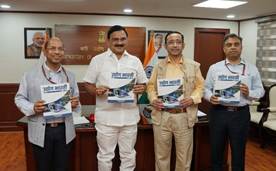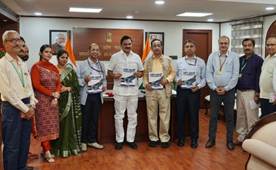The Ministry of Heavy Industries has taken another step forward in encouraging the use of Hindi within government operations. On 31 October 2025, the Minister of State, Shri Bhupathiraju Srinivasa Varma, unveiled the latest issue of the department’s Hindi publication titled Udyog Bharti. This event marks a continued push towards making official language policies more effective across various sectors.

Event Highlights and Key Participants
The launch took place in New Delhi with several senior officials in attendance. Among them were Shri Kamran Rizvi, who serves as Secretary in the ministry, Dr. Hanif Qureshi holding the position of Additional Secretary, and Shri Vijay Mittal as Joint Secretary. Their presence underlined the importance the department places on linguistic initiatives alongside its core industrial responsibilities.
During his address, the Minister emphasized how publications like this one play a vital role in everyday administrative functions. He pointed out that regular content in Hindi helps employees across different levels stay informed about policy changes, new schemes, and technical developments without language barriers.
Secretary’s Views on Team Effort
Shri Kamran Rizvi spoke appreciatively about the staff members who worked on putting together this edition. He noted that creating quality material in Hindi requires coordinated effort from writers, editors, designers, and translators. According to him, such teamwork not only produces a readable magazine but also sets an example for other government bodies to follow similar practices.

What Makes This Edition Special
Readers can expect a mix of articles covering recent achievements in heavy industries, updates on ongoing projects, and explanations of government schemes. The content is crafted to be accessible to both technical experts and general staff members. Topics range from manufacturing advancements to sustainability measures being implemented in various plants.
One notable section focuses on success stories from different parts of the country where Hindi has been successfully integrated into daily operations. These real-life examples serve as motivation for other units that might still rely heavily on English documentation.
Alignment with National Language Policy
This initiative fits perfectly with the broader goals set by the central government regarding official languages. By producing regular Hindi content, the ministry demonstrates practical commitment rather than just policy statements. It shows how departments can maintain efficiency while honoring constitutional provisions about language use.
Over the years, many organizations have struggled with implementing Hindi in technical fields due to terminology challenges. Udyog Bharti addresses this by including glossaries and simplified explanations of complex terms. This approach makes specialized knowledge available to a wider audience within the workforce.
Impact on Ministry Operations
Having a dedicated publication serves multiple purposes beyond mere information sharing. It creates a repository of official records in Hindi, which proves useful during audits and training programs. New recruits find it easier to understand procedures when materials are available in their preferred language.
Furthermore, the magazine encourages contributions from employees themselves. Many articles come from field officers who share their experiences with machinery upgrades or process improvements. This bottom-up approach ensures that content remains relevant to actual workplace needs.
Future Plans for Hindi Promotion
Looking ahead, the ministry intends to expand digital access to these publications. Plans include developing an online archive where past issues can be downloaded easily. There are also discussions about starting regional language editions to cover areas where Hindi might not be the primary medium of communication.
Training workshops form another key component of the strategy. Regular sessions help staff improve their Hindi writing skills specifically for official purposes. These programs focus on report drafting, email etiquette, and presentation techniques in the language.
Reader Benefits and Engagement
For anyone working in or associated with heavy industries, this magazine offers valuable insights into policy directions. It keeps readers updated about budget allocations, international collaborations, and technology transfers happening in the sector. The clear language ensures that even non-experts can follow important developments.
Feedback mechanisms are built into each issue, allowing readers to suggest topics for future coverage. This interactive element helps maintain interest and relevance over time. Many previous suggestions have already been incorporated, showing that the publication values its audience input.
The design layout deserves mention for its clean presentation and logical flow. Sections are clearly marked, making it easy to navigate between different types of content. Photographs and infographics break up text-heavy pages, improving overall readability.
Growing Readership Base
Circulation figures indicate increasing popularity among ministry employees and partner organizations. Educational institutions focused on industrial training have also started requesting copies for their libraries. This wider reach helps spread awareness about government efforts in both industrial growth and language preservation.
In conclusion, the release of Udyog Bharti’s second edition represents more than just a publishing milestone. It embodies a sustained commitment to making government functioning inclusive and accessible through proper language use. As heavy industries continue to evolve, having reliable Hindi resources ensures that progress benefits everyone involved in the ecosystem.
